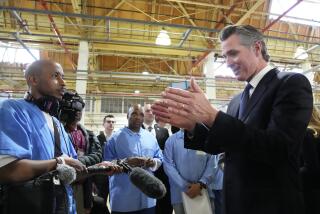Dead certain about his date with the hangman
- Share via
Back in the days when execution by lethal gas or hanging came “swift and sure” for San Quentin’s condemned — long before lengthy appeals and federal court rulings rendered death sentences academic — death row inmates could only dream of ways to “cheat the hangman.”
One young killer, William E. Hickman, tried diving off his bunk bed onto the concrete floor of his cell. It didn’t work. Caryl Chessman, the “Red Light Bandit,” was a pioneer of execution delays. Chessman was convicted in 1948, and he studied law and wrote a series of appeals that put off his date with cyanide gas for 12 years.
But one capital criminal stands apart in the history of executions in California. Dallas Egan, a Depression-era murderer, admitted his guilt and “gave no quarter and wanted none,” even when it came to carrying out his death sentence. His crime was a garden-variety robbery-killing, vicious but not extraordinary. What was unusual was his insistence on being hanged.
On the afternoon of July 23, 1932, the habitual criminal and a gang of accomplices held up a jewelry store at 768 S. Vermont Ave. Egan forced the proprietor, Sidney Broder, and a clerk into the back room. While Egan kept both men covered with his Springfield rifle, his partners (reportedly “two white men and a Negro”) gathered up $5,000 worth of jewels.
At just the wrong moment, a man approached the store’s front window. Squinting against the sun’s reflected glare, he peered inside, close to the open door. William J. Kirkpatrick, 76, a tourist visiting from Michigan, was innocently checking his watch against the clocks behind the glass.
Egan pointed his rifle at Kirkpatrick from the rear of the store and shouted at him to get behind the counter. But Kirkpatrick, who was deaf, couldn’t hear him. When the man didn’t budge, Egan pointed his rifle at him and fired. The window shattered and Kirkpatrick fell backward. Spectators screamed and Egan’s gang ran through the doorway, over Kirkpatick’s body and into a getaway car. The shop owner ran out, jumped into a stranger’s car and chased them for five blocks before giving up. Soon the coroner arrived.
Apprehended later, Egan protested lamely, “I gave the man full warning.” But he later admitted he was set on killing anyone who got in his way. Having already served a nine-year sentence at Folsom State Prison that included a long stretch in solitary, he had “come out embittered against society … with the intention that society owed me a duty, and I was going to collect that duty.”
Egan pleaded guilty to Kirkpatrick’s slaying and was sentenced to death, while his accomplices were tried separately. At his sentencing before Judge Isaac Pacht — a jurist with a strong aversion to the death penalty — Egan resisted his attorney’s request for a second, “sanity trial.” “I don’t know whether or not I’m insane,” he told Pacht. “We’re all a little crazy; even you, Judge. But I don’t want nine years’ punishment, or 20 years. I want to pay in full!” Dallas Egan’s only request was that he be hanged at San Quentin, not Folsom. Pacht reluctantly agreed.
On death row, Egan quietly awaited his execution. But CaliforniaGov. James Rolph — a controversial figure who had applauded a recent lynching in San Jose — took interest in Egan’s case and seemed bent on ordering a clemency hearing. Via prison authorities, Egan thanked him but would have none of it: “I can think of nothing better than the drop through the gallows. I’m a criminal at heart and I want to be hanged.”
Egan then wrote to the state Supreme Court, issuing this demand: “Should Mr. William T. O’Shaughnessy, my true and faithful attorney, overrule my voice … fine him $1.98 and court costs for having a heart too big for his Irish soul.”
The night before he was to be hanged, Egan asked for some whiskey. Rolph responded by telling prison officials to give him “all the whiskey he can safely stand up under,” enough to take the prisoner through the night and the morning of his doom. “Take care of him, and say goodbye for me, too,” the governor said. Eight ounces of high-quality Kentucky bourbon was duly delivered to the death cell.
Egan’s last morning, Oct. 20, 1933, began with a good breakfast, some final sips of whiskey and a cigar “tilted at a ridiculous angle,” according to one witness. The previous night he’d played a record of “Ida, Sweet as Apple Cider” over and over in his cell, telling guards: “I’ll dance out to that tune.” (Some newspapers misquoted this statement with the more formal “I want to dance out to the gallows.”)
When the hour came, he really did dance an Irish jig as he entered the death chamber handcuffed between guards. He then walked up the 13 steps, energetically and alone. Offering no final words, he plunged through the trapdoor.
Rolph’s generosity toward Egan resulted in a two-day controversy. Some Bay Area preachers chided him for it, but Rolph had the last word: “We would be pretty small when we sent a man into eternity if we could not grant his last request.”
More to Read
Sign up for Essential California
The most important California stories and recommendations in your inbox every morning.
You may occasionally receive promotional content from the Los Angeles Times.













